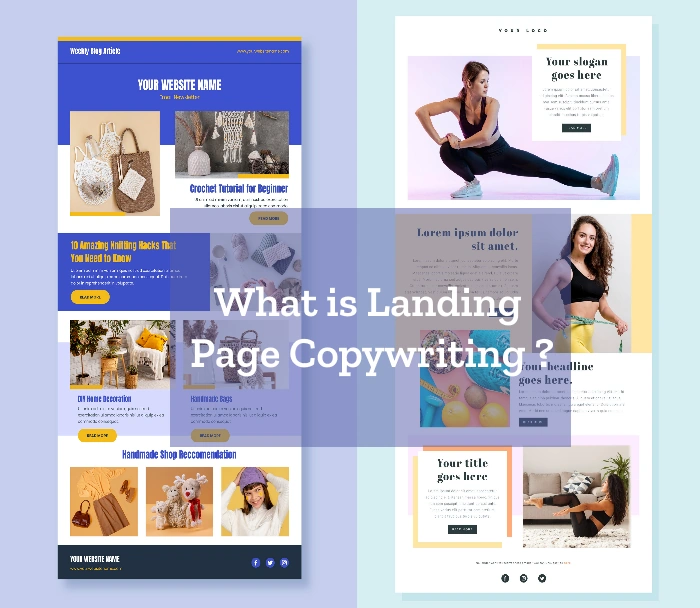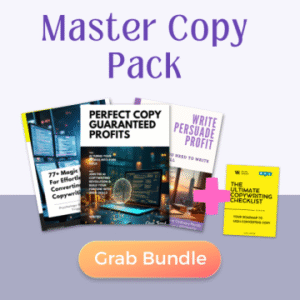You’ve built your landing page. The design looks sleek. But visitors keep bouncing faster than a rubber ball on concrete. Sound familiar? The culprit isn’t your design—it’s your copy. What is landing page copywriting? It’s the strategic art of writing words that turn curious visitors into paying customers on a single, focused web page. Think of it as your 24/7 digital salesperson that never takes a coffee break. Key point: Master landing page copywriting, and you’ll transform casual browsers into loyal customers without spending a fortune on ads.
What Makes Landing Page Copywriting Different From Regular Writing?
Let me tell you about my first landing page disaster. I wrote it like a college essay—long paragraphs, fancy words, zero personality. The conversion rate? A whopping 0.2%. Ouch.
Landing page copywriting isn’t about showing off your vocabulary. It’s about creating standalone web pages specifically designed for marketing campaigns. Unlike blog posts or website copy, every single word has one job: get visitors to take action.
Here’s what sets landing page copy apart:
• Single focus: One goal, one action, one outcome • Visitor-first language: Speaks directly to your audience’s needs
• Urgency-driven: Creates compelling reasons to act now • Conversion-optimized: Every element pushes toward the desired action • Measurable impact: You can track exactly what works
Regular website copy educates and informs. Landing page copy converts and sells. Big difference.
Discover also:
- Landing Page Copywriting Template: Your Fast-Track to High Conversions
- Landing Page Copywriting Secrets: From 0.8% to 15% Conversion Rate
- 50+ Killer Landing Page Copywriting Prompts That Actually Convert
The Core Elements Every Landing Page Copy Needs
Want to know what separates winning pages from losers? It’s not rocket science. Every high-converting landing page follows the same blueprint.
Headlines That Hook Instantly
Your headline carries 80% of your page’s weight. No pressure, right? Focus on benefits over features—visitors care about what your offering does for them, not what it is.
Weak headline: “Our Advanced CRM Software”
Strong headline: “Close 40% More Deals Without Working Weekends”
See the difference? The second one promises a specific outcome your audience actually wants.
Value Propositions That Sell
Your value proposition answers the visitor’s burning question: “What’s in it for me?” Keep it simple. Keep it specific. Keep it benefit-focused.
Template: “Help [target audience] achieve [desired outcome] without [common obstacle]”
Social Proof That Builds Trust
Nobody wants to be the first person to try something new. Include testimonials, reviews, case studies, or client logos. Even simple statements like “Join 10,000+ marketers” work wonders.
Clear Call-to-Action Buttons
Your CTA button isn’t decoration—it’s your closer. Use action words like “Get,” “Start,” or “Download.” Avoid weak phrases like “Submit” or “Click Here.”
Landing Page Copywriting vs. Sales Page Copywriting: What’s the Difference?
Here’s where most beginners get confused. Both convert visitors, but they work differently.
Landing Page Copywriting: • Focuses on one specific offer • Aims at generating leads rather than immediate sales • Shorter, more focused content • Often collects contact information • Perfect for building your email list
Sales Page Copywriting: • Focused on selling products or services for monetary conversions • Longer, more detailed content • Addresses objections and concerns • Includes pricing and payment options • Designed for immediate purchase decisions
Think of landing pages as the handshake before the sales conversation. Sales pages are the full pitch meeting.
Step-by-Step Process to Write Landing Page Copy That Converts
Ready to write copy that actually works? Follow this proven process I’ve used to boost conversion rates by 300%+ for clients.
Step 1: Research Your Audience Obsessively
Before you write one word, know your audience better than they know themselves. What keeps them awake at 2 AM? What would make their job easier? What words do they use to describe their problems?
Create a simple audience profile: • Demographics (age, job title, experience level) • Pain points and challenges • Goals and desired outcomes
• Common objections and concerns
Step 2: Craft Your Hook
You’ve got 3 seconds to capture attention. Start with their biggest pain point or most desired outcome. Use the PAS formula:
• Problem: Identify what’s bothering them • Agitate: Make the problem feel urgent • Solution: Present your offer as the answer
Step 3: Structure Your Copy Flow
Follow this proven template:
- Headline: Promise a specific benefit
- Subheadline: Expand on the promise
- Value proposition: Explain what you offer
- Benefits list: Show what they’ll gain
- Social proof: Build credibility
- CTA: Tell them what to do next
Step 4: Write Like You Talk
Ditch the corporate speak. Write like you’re explaining your offer to a friend at coffee. Use contractions, ask questions, share quick stories.
Formal: “Our solution facilitates enhanced productivity optimization.”
Conversational: “You’ll get more done in less time—without the stress.”
Step 5: Test and Optimize
Launch your page, then start testing. Change one element at a time: • Headlines • Button colors • Form fields • Value propositions
Track what improves your conversion rate, then double down on what works.
Common Landing Page Copywriting Mistakes (And How to Fix Them)
I’ve seen these mistakes kill more conversions than a broken checkout page. Don’t be that person.
Mistake #1: Talking About Features Instead of Benefits
Wrong: “Our software has advanced analytics”
Right: “See exactly which campaigns bring in the most customers”
Features tell. Benefits sell.
Mistake #2: Using Weak, Generic Headlines
Generic headlines blend into the noise. Be specific about the outcome you’ll deliver.
Weak: “Improve Your Marketing”
Strong: “Get 50% More Qualified Leads in 30 Days”
Mistake #3: Creating Friction in Your Forms
Long forms kill conversions faster than slow loading times. Ask for the minimum information you actually need. Name and email often work better than a 10-field survey.
Mistake #4: Burying Your Value Proposition
Visitors shouldn’t have to hunt for what you’re offering. State your main benefit above the fold, in plain English.
Mistake #5: Forgetting Mobile Users
Over 60% of traffic comes from mobile devices. Your copy needs to work on small screens. Keep paragraphs short. Use bullet points. Make buttons finger-friendly.
Tools and Resources That’ll Level Up Your Copy Game
The right tools make landing page copywriting faster and more effective. Here are my go-to resources:
Writing and Research Tools
• Answer The Public: Discover what questions your audience asks • Grammarly: Catch grammar mistakes and improve clarity • Hemingway Editor: Simplify complex sentences • Google Trends: See what’s trending in your industry
Conversion Optimization Platforms
• Unbounce: Build and test landing pages easily • Leadpages: Simple drag-and-drop page builder • Hotjar: See how visitors interact with your pages • Google Analytics: Track conversions and user behavior
Inspiration Sources
Study high-converting landing pages in your industry. Screenshot the good ones. Analyze what makes them work. Build a swipe file of effective headlines, value propositions, and CTAs.
Real Examples That Actually Convert
Let me show you what good landing page copywriting looks like in action.
Example 1: Lead Generation Page
Headline: “Get the Email Templates That Generated $2.3M in Sales”
Subheadline: “Download 47 proven email templates that turn cold prospects into paying customers—free for the next 48 hours”
CTA: “Send Me the Templates”
Why it works: Specific outcome, social proof, urgency, clear action.
Example 2: Free Trial Page
Headline: “Stop Losing Sleep Over Your Marketing ROI”
Subheadline: “Track exactly which campaigns drive revenue with our 14-day free trial—no credit card required”
CTA: “Start My Free Trial”
Why it works: Emotional hook, removes risk, benefit-focused.
Notice how both examples focus on outcomes, not features. They speak directly to visitor pain points and offer clear solutions.
Advanced Strategies for Higher Conversions
Ready to take your copywriting to the next level? These advanced techniques can boost conversions by 50% or more.
Use Micro-Commitments
Instead of asking for a big commitment upfront, start small. Instead of “Buy Now,” try “See Pricing” or “Learn More.” Once visitors take a small step, they’re more likely to take bigger ones.
Address Objections Directly
Your visitors have concerns. Address them head-on. Use sections like: • “But what if it doesn’t work for me?” • “I don’t have time to learn something new” • “This seems too good to be true”
Create Urgency (But Don’t Lie)
Real urgency converts. Fake urgency backfires. Use genuine deadlines, limited spots, or time-sensitive bonuses.
Good: “Early bird pricing ends Friday”
Bad: “Only 2 left in stock” (when you have hundreds)
Leverage Loss Aversion
People hate losing more than they love gaining. Frame your offer around what they’ll miss out on without it.
Gain-focused: “Increase leads by 40%”
Loss-focused: “Don’t let competitors steal 40% of your potential customers”
Frequently Asked Questions About Landing Page Copywriting
Q: How long should landing page copy be?
A: Long enough to convert, short enough to keep attention. For simple offers, 300-500 words work well. Complex products might need 1,000+ words. Test both approaches to see what your audience prefers.
Q: Should I include pricing on my landing page?
A: It depends on your goal. For lead generation, skip pricing and focus on value. For direct sales, transparent pricing often increases trust and qualified leads.
Q: How do I write copy when I don’t have testimonials yet?
A: Use other forms of social proof: client logos, media mentions, industry certifications, or even your personal story and credentials. Build credibility however you can.
Q: What’s the biggest copywriting mistake beginners make?
A: Writing about themselves instead of the visitor. Every sentence should answer “What’s in it for me?” from the reader’s perspective.
Q: How often should I update my landing page copy?
A: Test major changes monthly, small tweaks weekly. Always have a reason for changes—don’t just change for change’s sake.
Conclusion: Your Next Steps to Landing Page Copy Success
What is landing page copywriting? It’s your secret weapon for turning website visitors into customers, subscribers, and fans. It’s the difference between pages that convert at 0.5% and pages that convert at 15%.
Here’s your action plan:
- Start with one page: Don’t try to optimize everything at once
- Know your audience: Research their language, pain points, and desires
- Focus on benefits: Tell visitors what they’ll gain, not what you offer
- Keep it simple: Clear beats clever every single time
- Test everything: Small improvements compound into big results
Remember, even seasoned marketers mess this up sometimes. I still write headlines that flop harder than a fish on dry land. The difference? I test, learn, and improve.
Your landing page copy doesn’t need to be perfect—it just needs to be better than what you have now. Start writing, start testing, and start converting more visitors into the customers your business deserves.
Ready to transform your landing pages? The only thing standing between you and higher conversions is the willingness to start. Your future self will thank you for taking action today.

